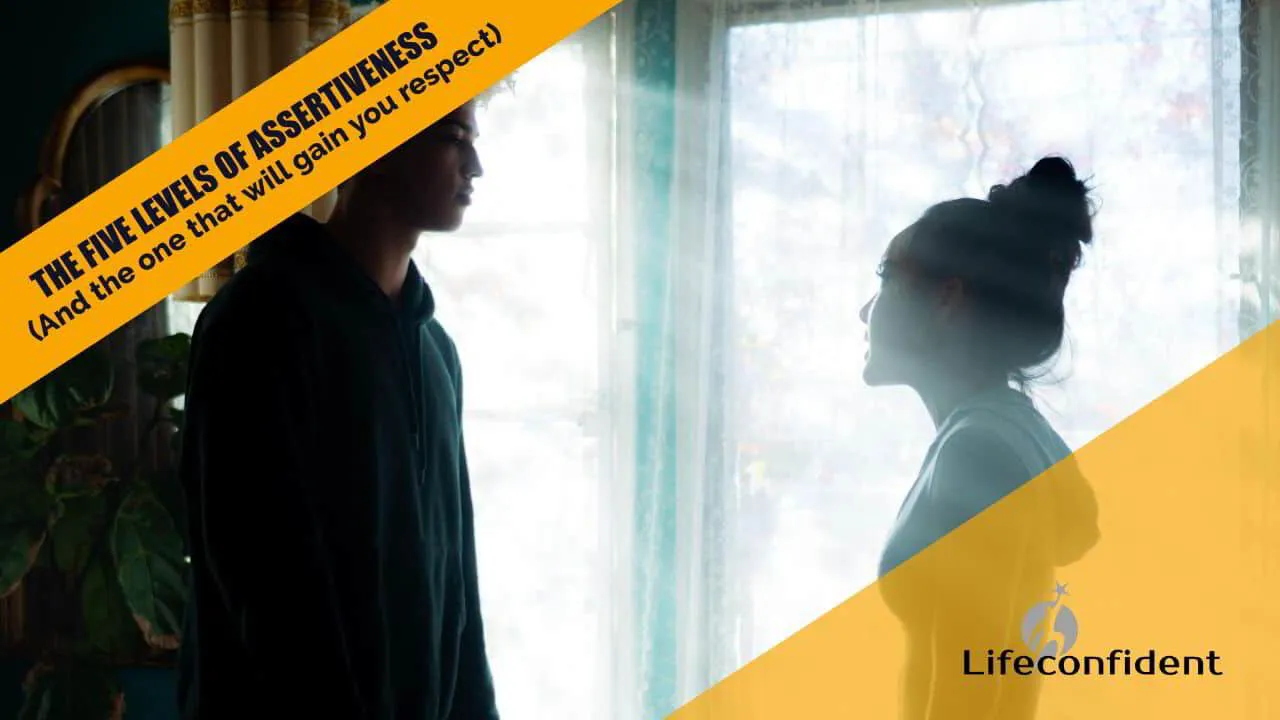Either you are an assertive person who can speak up for yourself and stand your ground, or you are being passive, and diminishing your place in this world. In this article we will look at the five different levels of assertiveness, and identify where you are currently at, and how you can move to the right level.
When you imagine assertive people, preconceived images may appear in your mind. Images of a no-nonsense boss aggressively barking orders. Someone who will talk over you and dominate you in a work or social situation.
If you associate negative images like these with the idea of assertiveness, then your subconscious will sabotage your attempts to develop more assertive behaviour, and become something you revile.
With that in mind, lets begin by defining what assertive communication IS, and what it is NOT...
The five levels of assertiveness
Level 1. Passive
At this level, poor social skills translate into passive behaviour as you allow people to regularly walk all over you, and wipe their feet on your self-esteem.
Perhaps a childhood of negative messaging has turned a shyness trait into social anxiety, and made you feel worthless as an adult. As a result, you end up occupying the bottom rung of the work ladder, where being talked down to, and being told what to do is such a normalised part of life, you barely notice anymore.
At the far left of the assertiveness scales, you feel you have no value in society, and nothing interesting to contribute, so you don't speak up or stand up for yourself - because there is nothing to stand up for...
Level 2. Insecure
At this level, you are still stuck in a passive behavior pattern. You will still find yourself on the lower rungs of the work ladder, and low in the social pecking order where others can get the best of both worlds from you.
The difference between level one and two, is that you are aware of your own values, beliefs, and ideas on life, but you are not confident enough in them, to stand up for them. This lack of confidence makes you over-compensate by being more agreeable with the views of others.
This people pleasing behaviour makes you popular, but for the wrong reasons. You are occupying the low ground in any work or social situation, and others want to keep you there because their own sense of self feels inflated by comparison.
Level 3. Assertive.
This is the middle of the scale, the level playing field, the happy medium between interpersonal, and intrapersonal intelligence skills. You know your own mind, what you want, what you will settle for, and where you draw the line etc. This is your intrapersonal emotional intelligence at play.
Translating your thoughts and ideas, your wants and feelings into words, and communicating them to others
confidently, and with good eye contact, is your interpersonal social intelligence at play.
You have found the right balance of assertive behavior, but good emotional intelligence means you also give others the space to express themselves. Even if that means sometimes fielding constructive criticisms :)
Level 4. Self-Importance.
At this level, you have elevated your own needs and values to where they now feel more important than those of people around you. You arrived at level three and then overshot the mark :(
You may feel that you know better than others due to certain factors, including your higher status at work or in social groups, and the influence of level two people-pleasers massaging your ego.
The need to be heard is a fundamental human need. To have that drowned out by a level four voice, creates resentment. Getting back to a healthy, assertive level, means recognising that the thoughts and opinions of others are just as important as your own.
Level 5. Aggressive
This is the level we first proposed assertiveness might look like to you. A person who uses passive aggressive behavior tactics to get their way, such as:
- dominating body language
- raised voice
- belittling
- even intimidation
These are the ones that have lost sight of what it means to be assertive, and have become a bully instead.
If this is what runaway assertiveness looks like to you, then test yourself with the following short anecdote about a dysfunctional mother daughter relationship. Decide which of the characters was displaying real assertiveness...
Mother and daughter go head to head
I was walking in a park one day as an unraveling mother and daughter drama drifted into earshot.
They we walking toward me and I could see mum’s jaw was clenched, her face set in stony granite. She had just had an altercation with one of her daughters, and now she was steaming with anger. Her two girls of about age seven were in tow.
One walked silently at her side, eyes down. The other followed some five steps back, crying bitterly and holding her head. Mum turned on her crying child once more and shouted at her to shut up.
It was all I could do to hide a smile and hug the girl when I heard her logical, innocent, and deeply felt response to her mother’s public attack.
This particular girl was certainly hurting from where her mother had used her physical presence, and position of authority to dominate her daughter. But instead of being bullied into passivity, the girl was determined to stand up for herself, and protect her boundaries.
Between gasping sobs, the girl made her defiant response:
‘Oh what! so you just want me to be quiet? I don’t think that’s how it’s supposed to be when somebody hits somebody...’
Childhood can certainly feel like a very harsh and unfair place when we are young. A place where we walk a fine line between asserting ourselves, but not standing out too far for fear of attracting retribution, and the attention of the bullies.
We have touched upon it as a launch stage for people who occupy level one on the assertive scale.
In this anecdote however, the girl had just returned serve beautifully, against one of the many negative messages that a child may absorb on a daily basis. Messages like:
You can't do that...
You're stupid...
You’ll never amount to anything...
Words that will ultimately shape a child’s belief system. Belief’s that will determine whether they arrive into adulthood confident, and ready to shape the world, or whether they will arrive bruised and battered.
A world that will talk over you, try and bend you to its will, and never simply give you your place. Until you realise, life is passing you by and you have to make a conscious choice to stand up and be counted.
How to be more assertive
As a child, you have no awareness of how negative messaging is writing your personality. But as an adult, you can continue using the coping strategies your developed in childhood, or you can choose to rewrite parts of your personality to reflect the way you want to be known for.
In the mother daughter anecdote, I bet you almost forgot there was a second daughter. That's because she was scared, and in all probability, would have meekly accepted, and internalised her mothers treatment - if it had been directed at her.
This child may grow up to become a level two character type - using people pleasing as a defense mechanism against attracting aggressive behaviours.
Having a healthy level of assertiveness in your character first means bringing your own opinions, your own beliefs, and your own boundaries into focus. Then getting comfortable with them.
The second part is to stand up and be counted, by confidently expressing yourself when the time is right. In the beginning, this may mean speaking up before you can over-think it and revert to a passive response.
Teach others how to treat you
We can't expect other people to listen to us unless we show them how we want to be treated. First, demonstrate your willingness to genuinely listen to the other person, and take their needs and perspectives into consideration.
Doing this is the difference between level four self-importance, and showing others you value their views. This comes with the proviso that you don't go to far and let your own boundaries be compromised, sending you back to level two.
Protecting your boundaries and keeping within level three will keep the playing field level, and gain you respect. Even when you sometimes say 'no' to their requests.
I'm Richard Gray, Founder of Lifeconfident.com, where we focus on melting away shyness and social anxiety, building skyscraper confidence, and developing cloud-bursting social skills. Thank you for reading.


